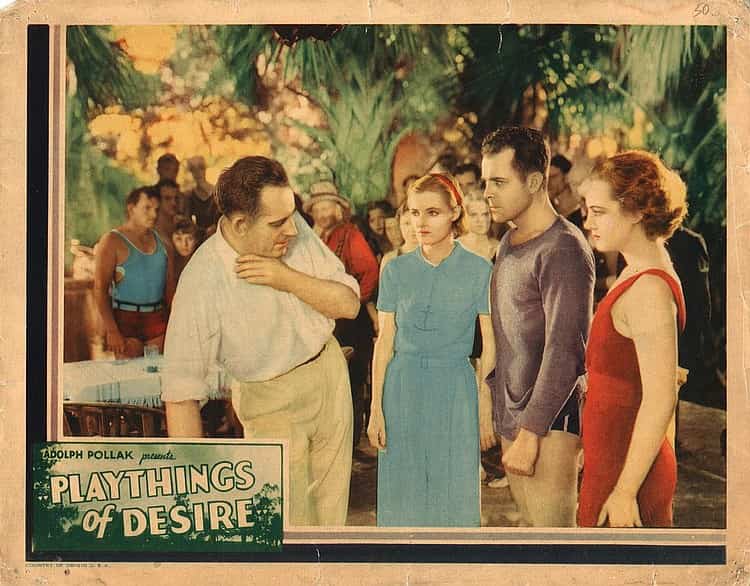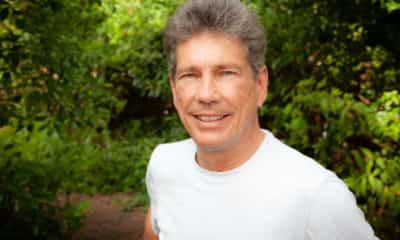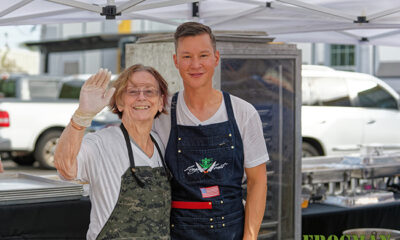Create
Vintage St. Pete: Making movies on Weedon Island

When the Great Depression enveloped America in the late 1920s, the curtain had just come down on the silent film era. Spirit-lifting “talkies” were all the rage, when Pinellas County – and, in particular, the scrubby landscape of Weedon Island – came tantalizingly close to becoming the Hollywood of Florida.
Local developer Fred Blair’s San Remo nightclub, shuttered by Prohibition, was idle and rotting away in early 1933. Smooth-talking Baltimore entreprenuer T.C. Parker arrived and convinced Blair to back him in a Florida movie studio; with the addition of Hollywood producer Aubrey Kennedy (to add authenticity to their project and act as a “lure” for others in the business), they purchased an additional 500 acres on Weedon Island.
The San Remo was to be gutted and refurbished as soundstages and office space for the ambitious project, initially called Kennedy City. Contracts, it was reported, were signed for 36 motion pictures.

Olive Borden
Production began on Chloe, the first venture, on May 22, 1933. A drama set in the Louisiana bayou, it’s the story of a young, white girl (silent film veteran Olive Borden) who’s been raised in a shack by an old black woman (Mandy, played by Georgette Harvey) she’s always believed to be her mother.
Harvey’s character happens to be a “voodoo priestess,” and when doe-eyed young Chloe’s birth family comes a-looking for her, there’s hell to pay. Mandy vows revenge.
Putting aside the regrettable racial stereotypes of the era, the wooden acting (Borden never adapted to sound movies, and this would be her final performance) and the inane dialogue, Chloe (later re-titled Chloe, Love is Calling You) gives us fascinating, if brief, glimpses of 1933 Pinellas County:

Georgette Harvey
The setting for numerous scenes (including the inevitable “love clinch” between Borden’s Chloe and her beau-to-be, played by future B-movie star Reed Howes) looks very much like Lake Maggiore – then called Salt Lake – and the winding, wooden trails of what’s now known as Boyd Hill Nature Park.
An alligator-wrestling scene that starts at water’s edge (most likely a murky Weedon lagoon) continues with an underwater sequence shot 100 miles away at Silver Springs, where the water is crystal clear. And it’s obvious the animal being “wrestled” is either drugged or already dead.

Harvey and St. Pete extras in full Louisiana “voodoo” mode.
Other scenes were shot in the lush back yard of 630 20th Ave. Northeast, and at 305 South Hyde Park Avenue, Tampa.
The explosive finale, a (laughingly bad) nighttime “voodoo ceremony,” features a dozen local extras, mostly African Americans, dancing around a bonfire at the base of a giant live oak tree draped in Spanish moss.
Kennedy told the St. Petersburg Times that work on Chloe would be completed on June 1. But several scenes had to be re-shot after an Eastern Air transport plane carrying reels of unprocessed film crashed near Bowling Green, Virginia on June 4.
The cast and crew toughed out the reshoots in the intense heat and bugs of early summer.

Buster Keaton
Kennedy and his in-house director Marshall Neiland made the front page of the Evening Independent May 23 with the announcement that silent film comedian Buster Keaton – “as a draw, second only to Chaplin” – was arriving in St. Petersburg to begin a five-year contract with the Weedon Island studio.
Keaton was having difficulty transitioning into “talkies,” and the nascent studio system – where the big bosses, the money men, dictated every rule of production – was driving him to distraction.
(It later came to light that the deadpan star’s alcoholism had actually caused his unwitting dismissal from a lucrative MGM contract.)
Kennedy and his backers promised him complete creative control, so Keaton signed on the dotted line and flew to Florida.
Production on the first Keaton film is to start here in about three weeks. The new sound stage will be completed by that time and will be ready for use … with the coming to St. Petersburg of Keaton, St. Petersburg becomes second only to Hollywood in importance in the moving picture business. – Evening Independent/May 23, 1933
On July 2, the Times reported that Keaton and director Neilen had traveled to Havana, Cuba to scout additional locations for The Fisherman, the comedian’s first Kennedy-made feature. The film, it was revealed, was to begin shooting “within the week” on Weedon Island.
 Keaton leased an 11-room house on Snell Island, moved his wife and brother in, and was awarded the key to the city during a celebration at Williams Park. He played baseball for the Coca-Cola Bottlers, a St. Petersburg amateur team.
Keaton leased an 11-room house on Snell Island, moved his wife and brother in, and was awarded the key to the city during a celebration at Williams Park. He played baseball for the Coca-Cola Bottlers, a St. Petersburg amateur team.
“The comedian kept the grounds in an uproar with his nonchalance at third base and his antics at the plate,” reported the Independent, “swinging six or seven bats and calling the balls and strikes for the umpire.”
As work progressed on The Fisherman, however, the silent film legend grew discouraged with the area – particularly the humidity, which melted his heavy makeup and attracted insects, which stuck to his face. And with the Kennedy complex, which he complained was unfinished and lacked the technical personnel he required.
After less than three months in St. Petersburg, Keaton got on a plane and never returned; The Fisherman was left incomplete.
“As far as I knew he never got before a camera,” Evening Independent editor William G. Wiley would later write. “He did most of his work in a local bar where, from time to time, he entertained the customers by taking off his pants and sweeping the floor with them.”
 Work began just after Independence Day on Kennedy’s second picture. Directed by George Melford, Playthings of Desire was a melodrama about wealthy New Yorker Jim Malvern (James Kirkwood) who brings his new bride Gloria Dawn (Linda Watkins) from her New York home to his vast estate in Florida. There, a fun-loving “gang” of his city friends arrives as a surprise.
Work began just after Independence Day on Kennedy’s second picture. Directed by George Melford, Playthings of Desire was a melodrama about wealthy New Yorker Jim Malvern (James Kirkwood) who brings his new bride Gloria Dawn (Linda Watkins) from her New York home to his vast estate in Florida. There, a fun-loving “gang” of his city friends arrives as a surprise.
Things don’t go well, as the partiers quickly begin to wear out their welcome, and Malvern renews his acquaintance with old flame Anne (Josephene Dunn).
Reed Howes, the he-man hero of Chloe, returns as the he-man hero who saves Gloria from both humiliation and, in the end, a murder charge. Molly O’Day, who’d had a small role in Chloe, is also in the cast.
The first scene committed to film, on July 5, 1933, may be the best part of Playthings of Desire. The entire cast frolics in the Bayou Farms public swimming pool, at 5150 4th Street South, with Little Bayou and Tampa Bay clearly visible in the background.
There’s also a short sequence with the original Gandy Bridge over the actors’ shoulders.
Other scenes were shot in the wilds of Weedon, including one where a scary alligator – clearly tethered to the ground – attempts to “get at” Gloria (who faints dead away at the very sight of it).
The sprawling Donald Roebling Estate, in the Harbor Oaks area of Clearwater, stood in for Malvern’s oceanside mansion.
Playthings of Desire (U.K. title: Murder in the Library) had its world premiere in September at the Capitol Theatre in St. Petersburg, with hundreds of locals in attendance.
 Even the ever-cheerleading Times had trouble saying anything positive about the film. “While the plot is thin, it nevertheless is interesting,” read the next day’s review.
Even the ever-cheerleading Times had trouble saying anything positive about the film. “While the plot is thin, it nevertheless is interesting,” read the next day’s review.
The writer instead praised the scenery. “Much of the beauty of the settings for the picture is due entirely to nature, for nothing artificial had to be added to make the scenes more effective.”
Just as production was getting underway on Hired Wife, the studio’s third picture, Parker and a group of New York financiers bought out Kennedy’s interest in the company. A new production entity, Sun Haven Studios, would assume control and distribute the films.
“We plan to produce feature and program pictures at reasonably moderate costs,” Parker told the Times. “Nothing gigantic like Gold Diggers or 42nd Street, but the best pictures possible for $50,000. Some may run as low as $20,000.”
Parker also boasted that his company’s deal with the long-gone Keaton, for The Fisherman and other titles, was still in place, despite the fact that the comedian had already dissolved his prospective St. Pete production company, Flamingo Films, Inc. and returned to California.

Greta Nissen in “Hired Wife.”
Starring heavily-accented Norwegian silent film actress Greta Nissen, Hired Wife (U.K. title: Marriage of Convenience) began production in September on Weedon Island, with other scenes created at the Soreno Hotel in downtown St. Petersburg, and at the Florida Theater on 5th Street South. Returning director George Melford also shot a lengthy scene on and around the Eastern Air landing strip and airport facility on Weedon.
The cast included Kirkwood (from Playthings) and, in her third St. Pete film, Molly O’Day.
By the time Hired Wife premiered in March, 1934, Sun Haven Studios was a memory. According to the Internet Movie Database, federal agents swooped in and closed Parker’s movie complex for failure to pay taxes, taking the master prints of Chloe, Playthings of Desire and Hired Wife with them.
Weedon Island’s final filmmaking foray is not to be confused with Hired Wife, the 1940 screwball comedy starring Rosalind Russell.
Never restored, Chloe and Playthings of Desire are viewable online and as blurry DVD transfers; although prints of Hired Wife are known to exist, it is currently unavailable.
Today, no evidence of the film buildings remain on Weedon Island; the story of Aubrey Kennedy, Buster Keaton and Sun Haven Studios gets but a passing mention in the history section of the Weedon Island State Preserve Visitors’ Center.
This story appears in Vintage St. Pete: The Golden Age of Tourism – and More (St. Petersburg Press).








Arthur Sabin
March 22, 2023at6:15 pm
I used to ride my bike on Weedon Island back in the fifties where the movie studio was located and by then it was turned into a storage place for floats that were used in the St.Petersburg Festival of States Parade. I miss the Weeden Island wooden bridge which had great fishing. I used to snatch mullet from there with a cane pole & a snatch hook.